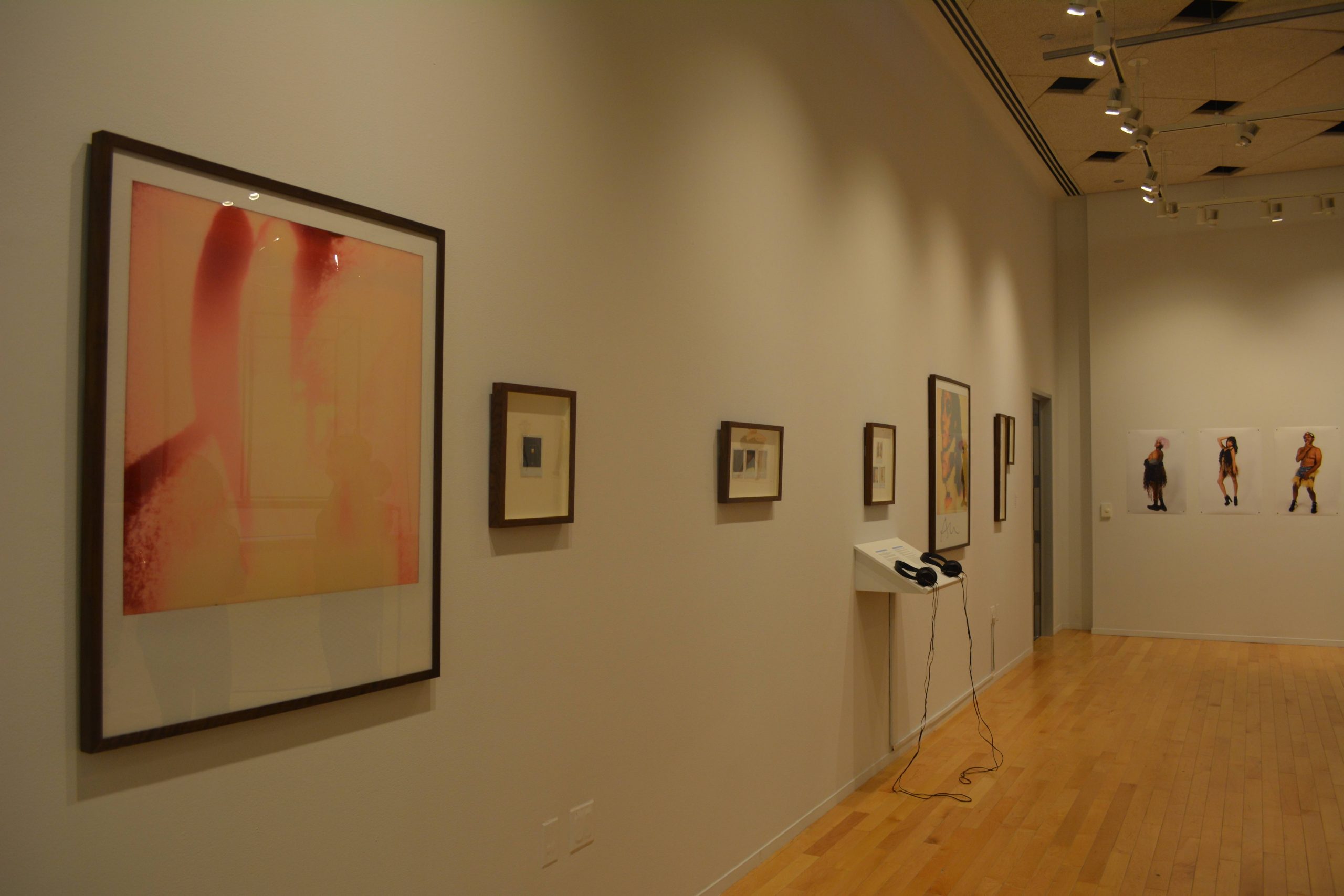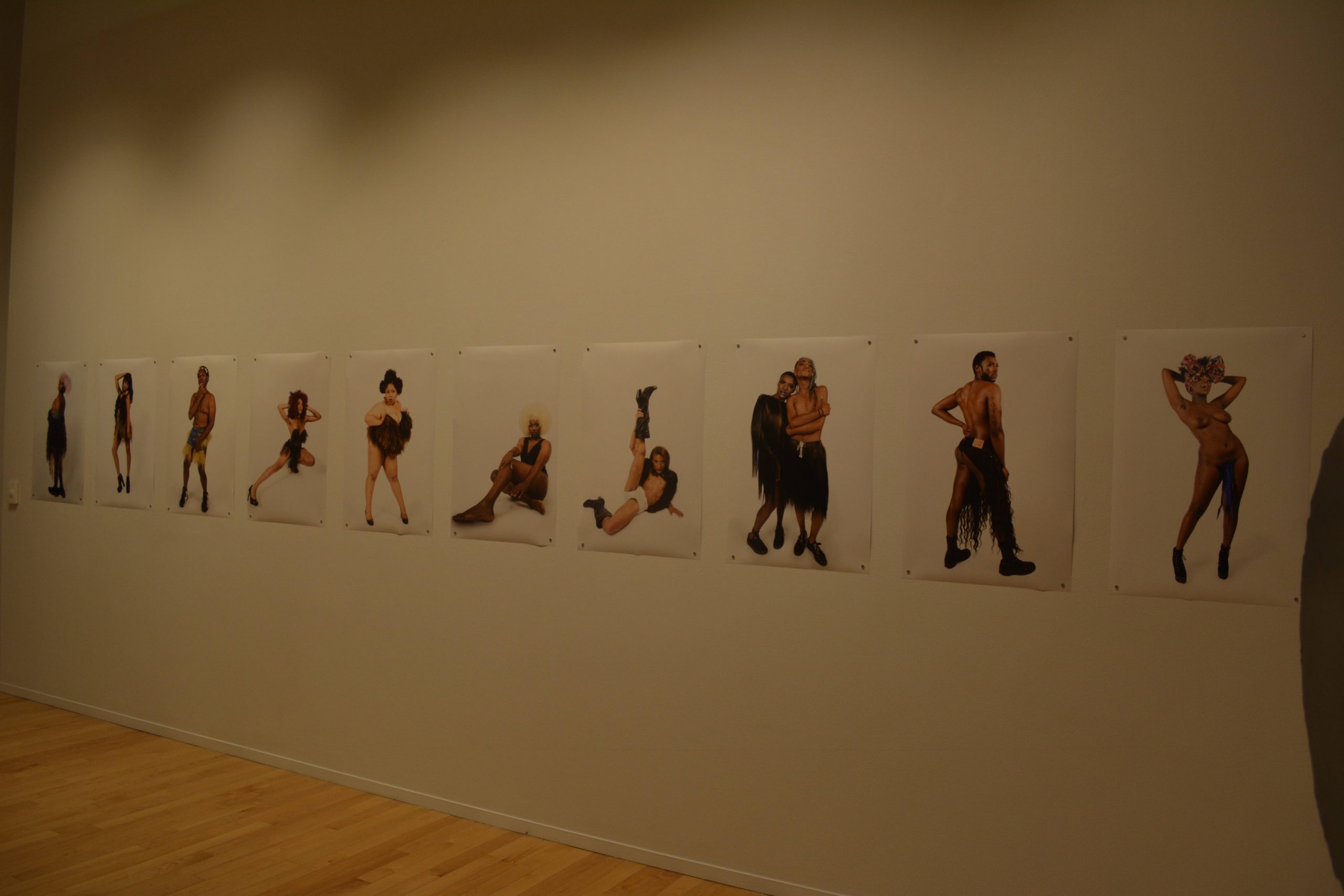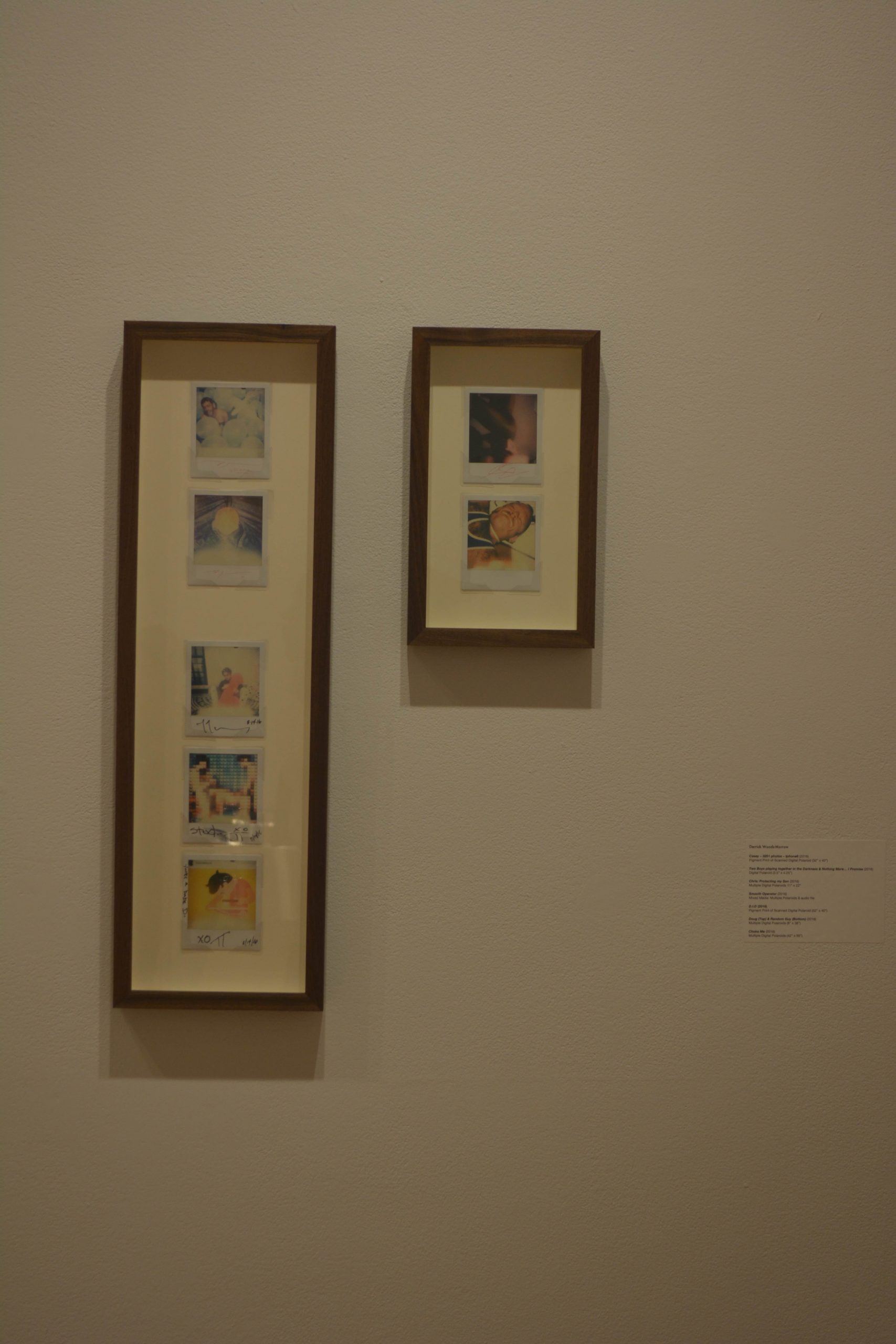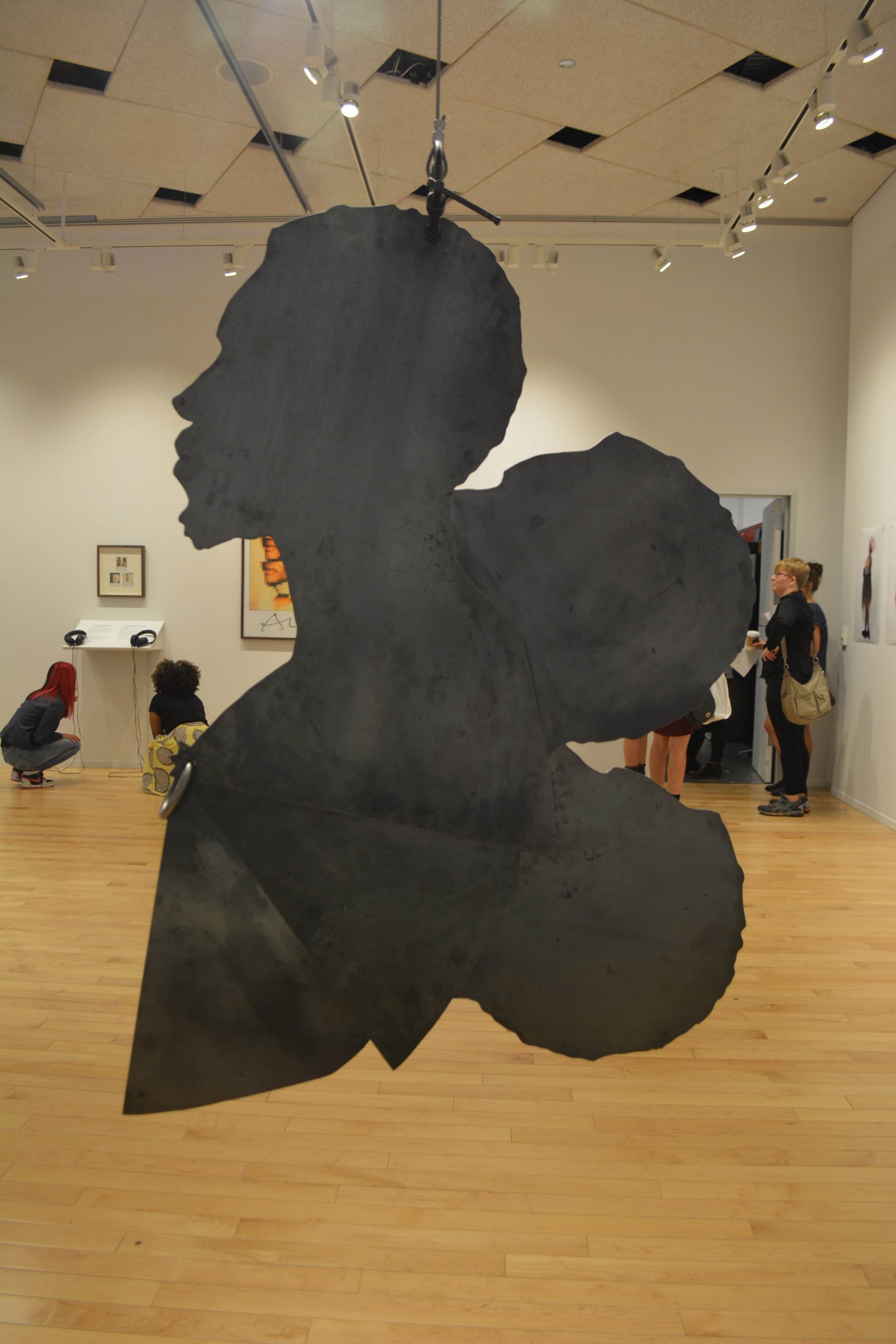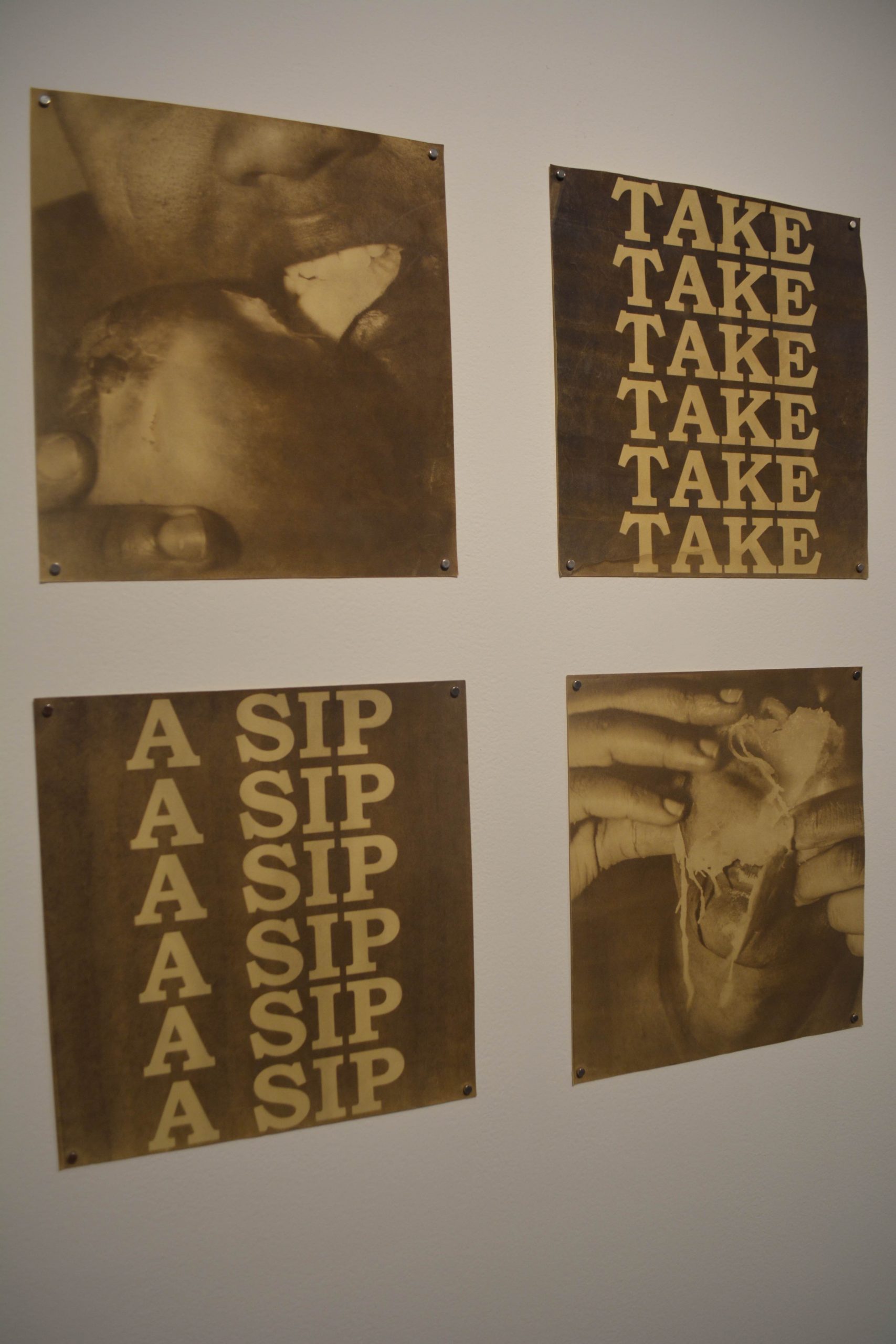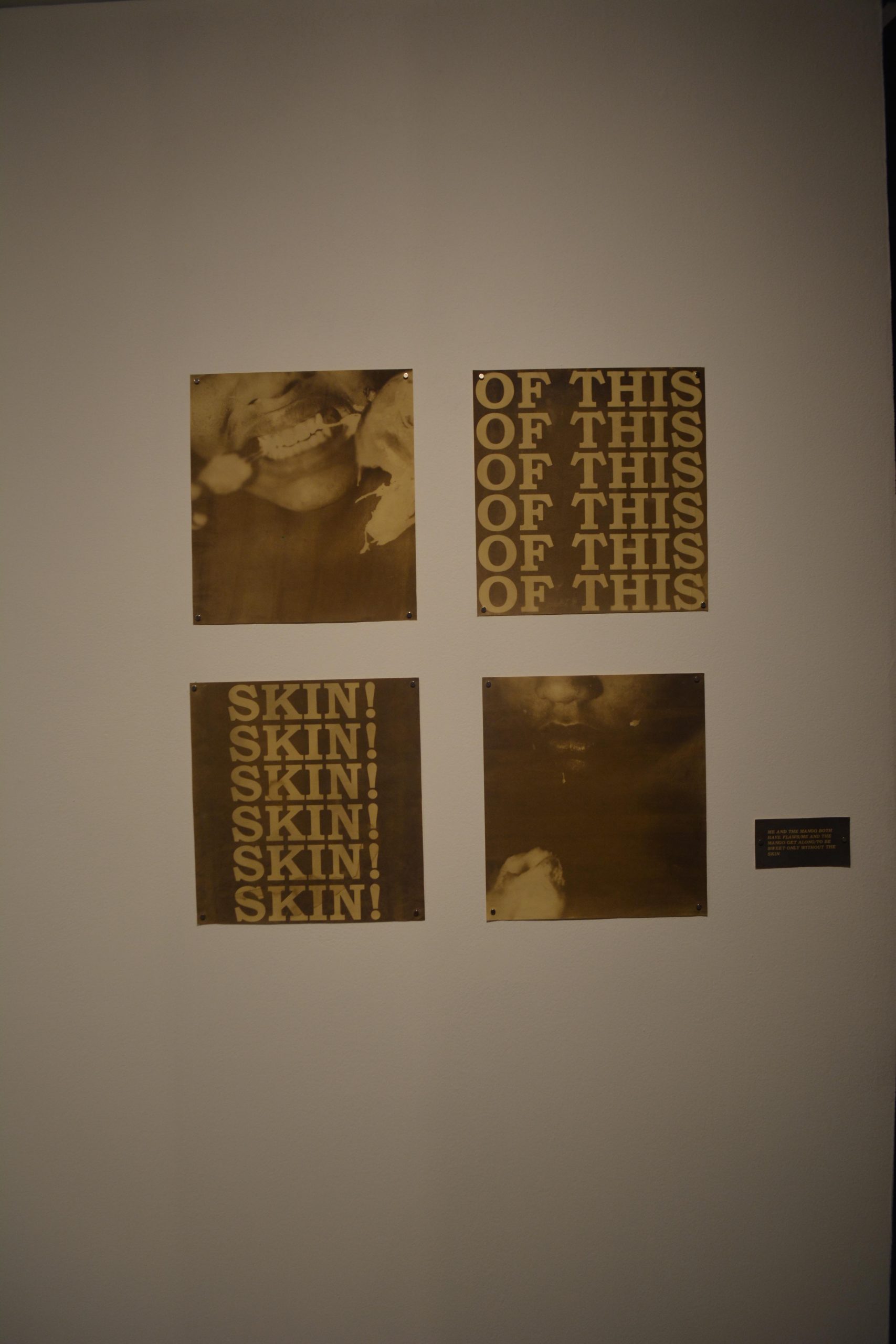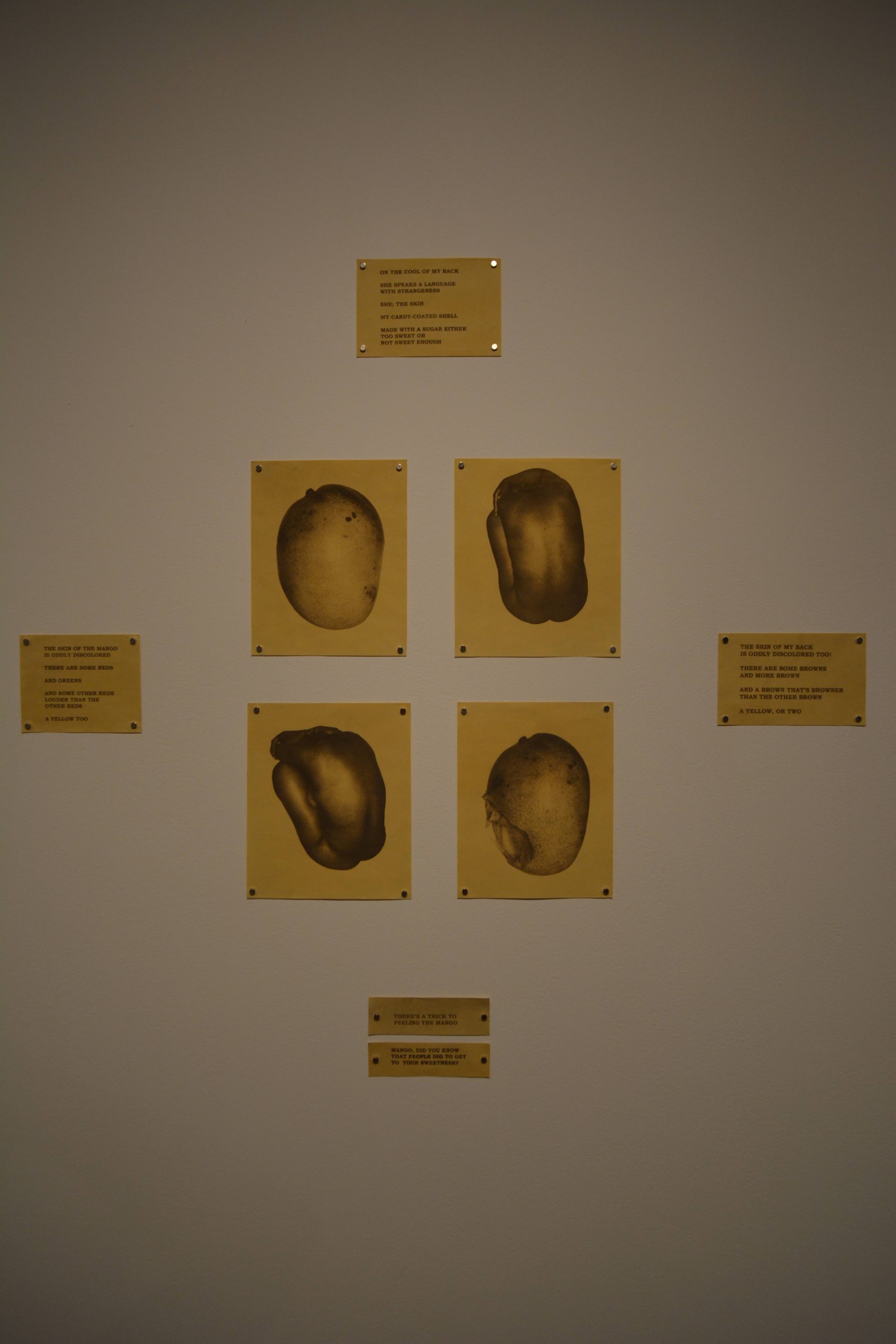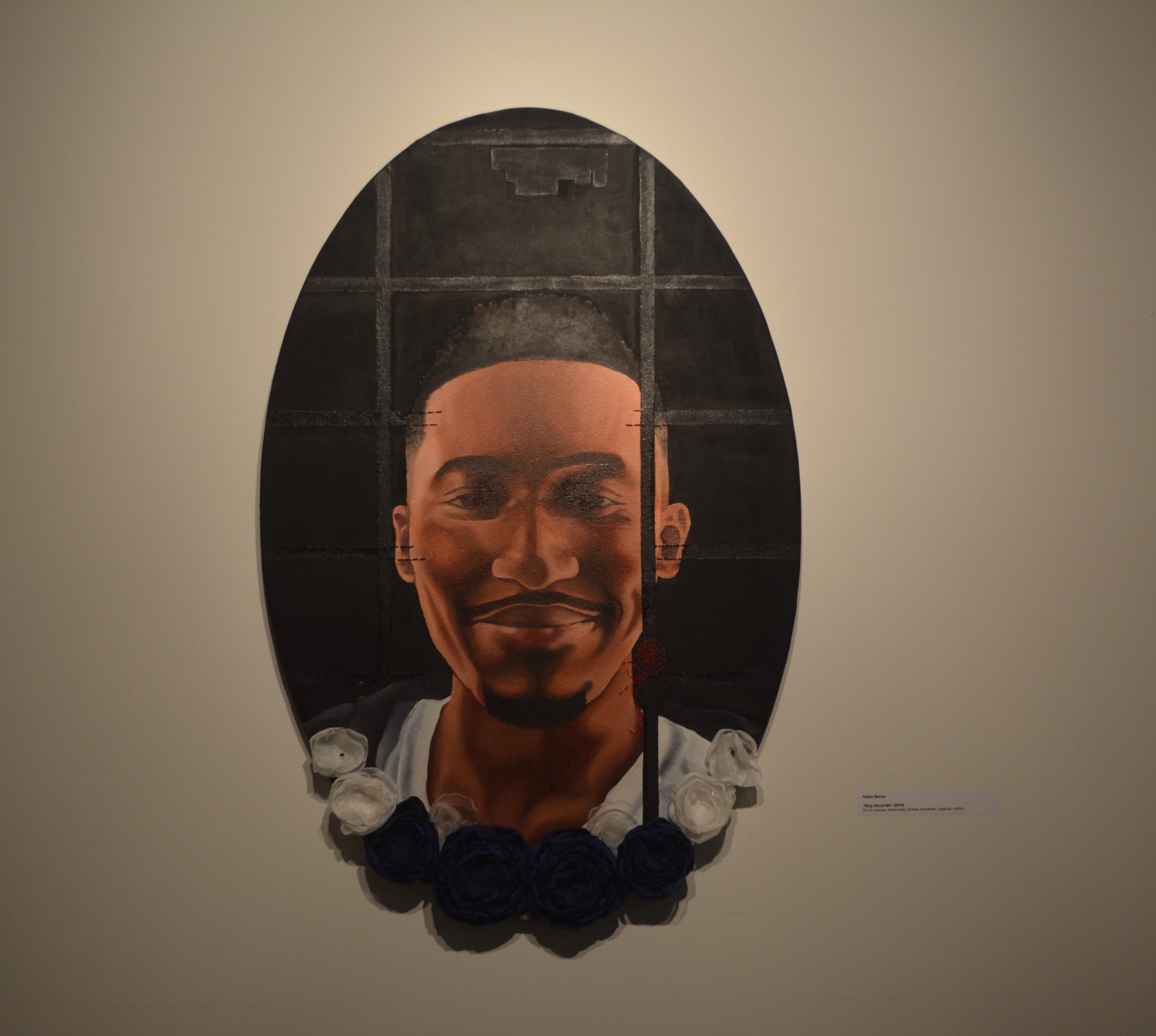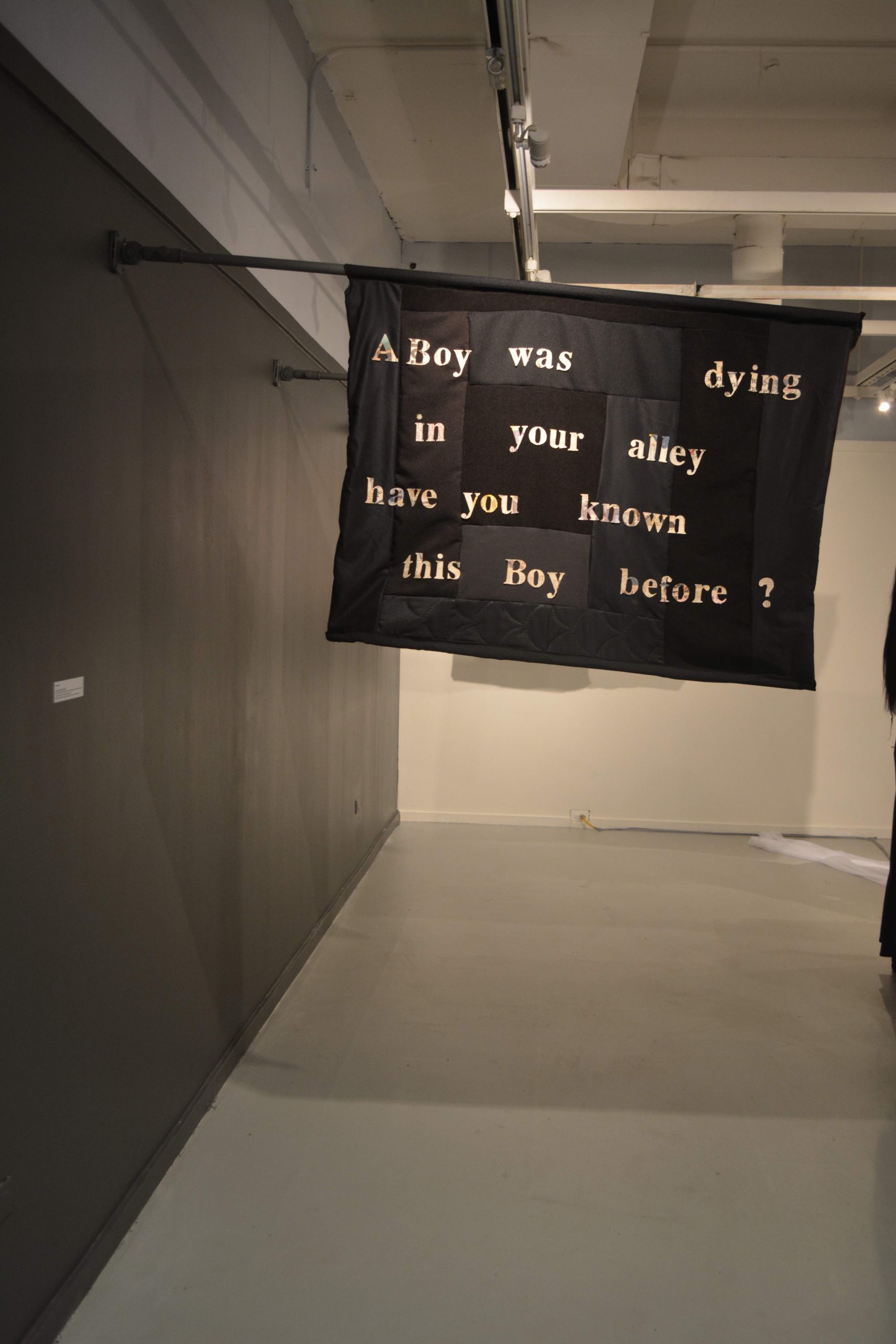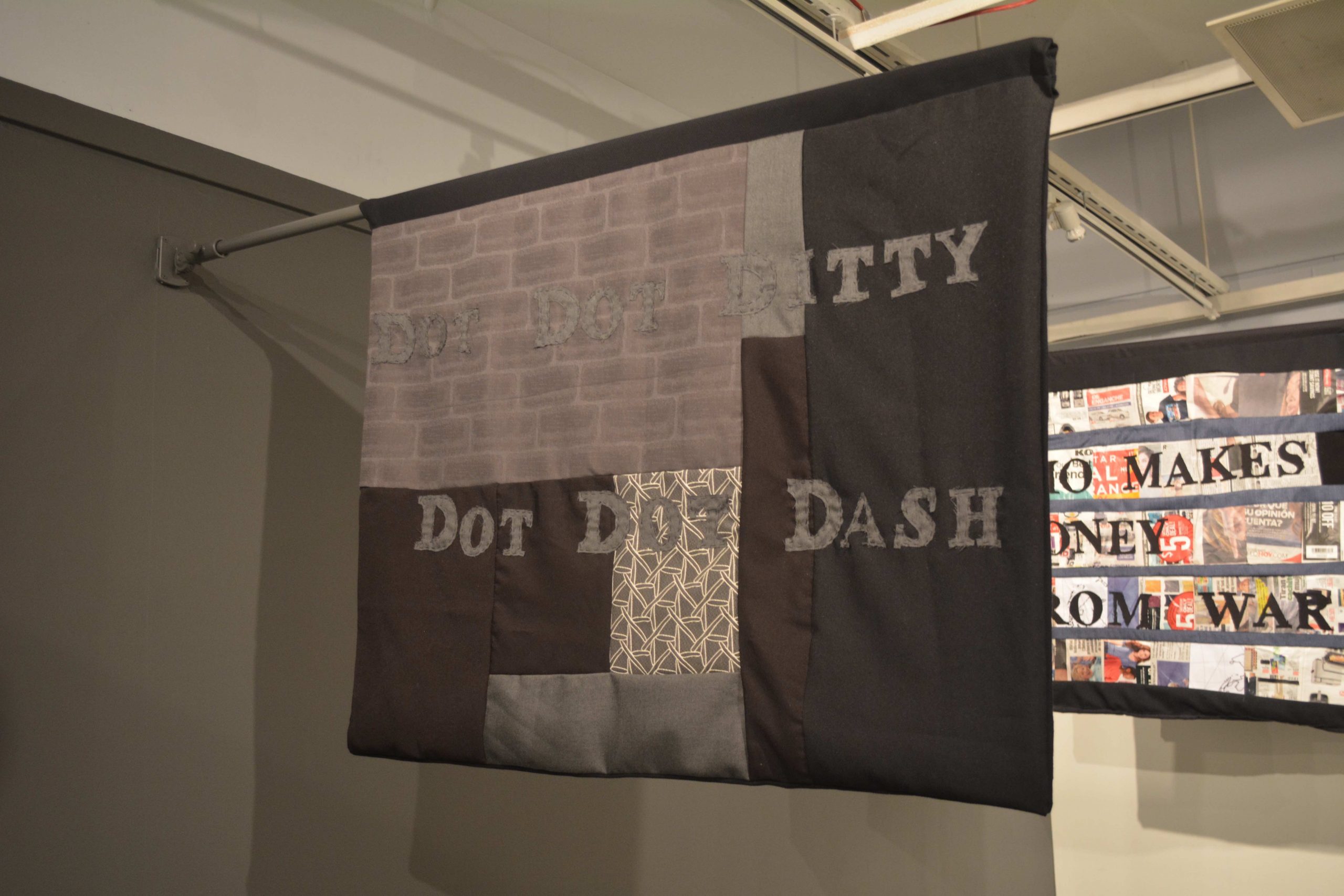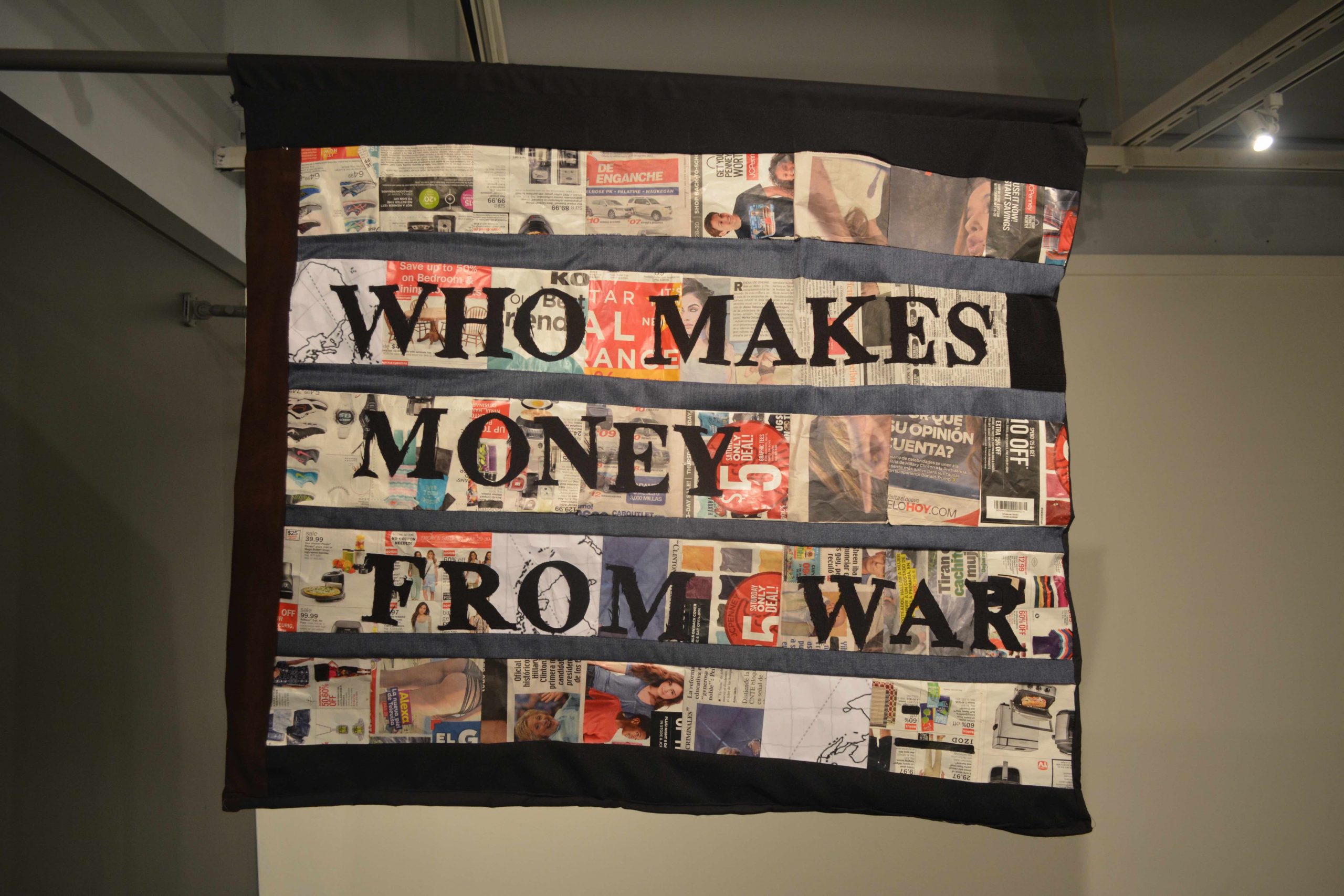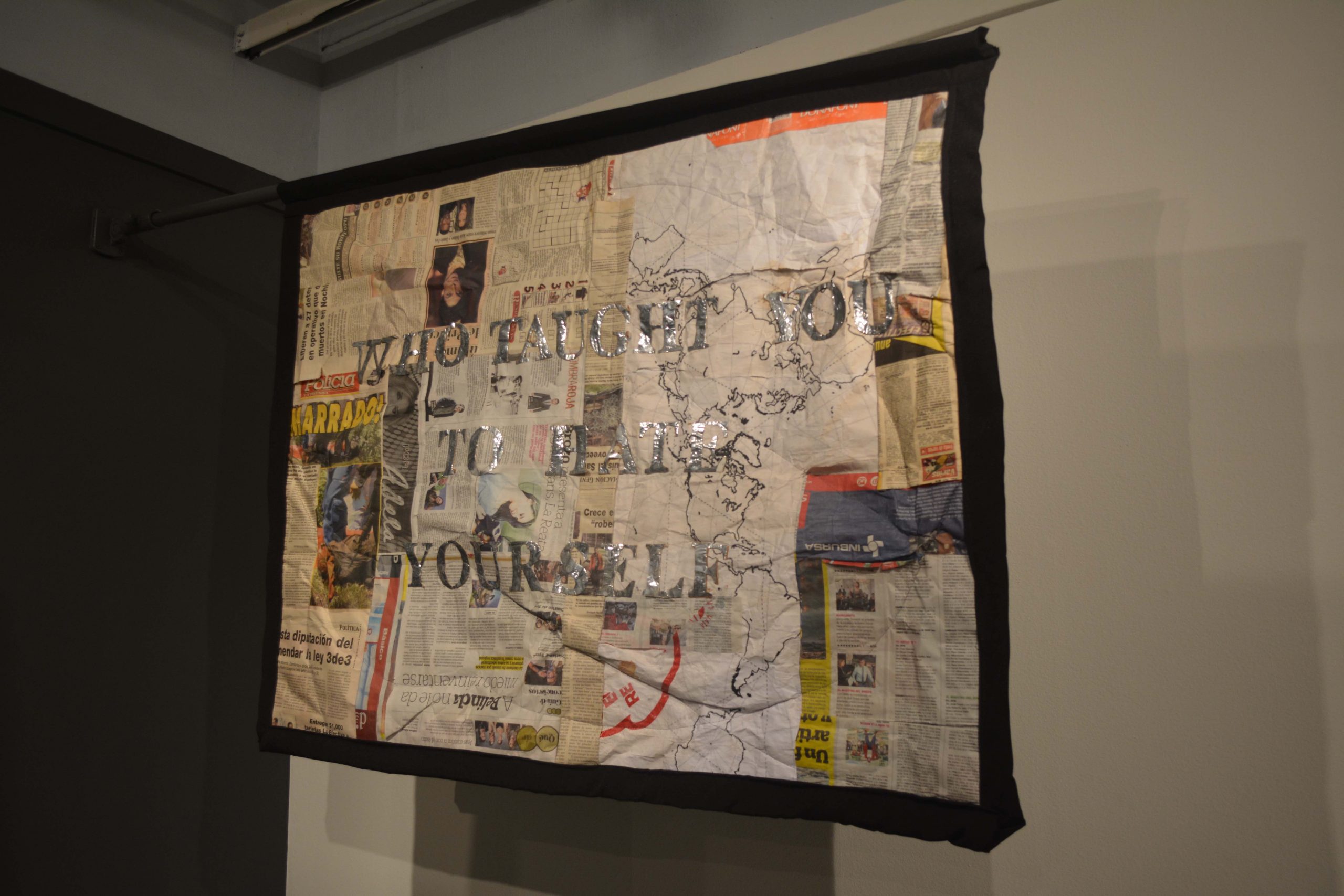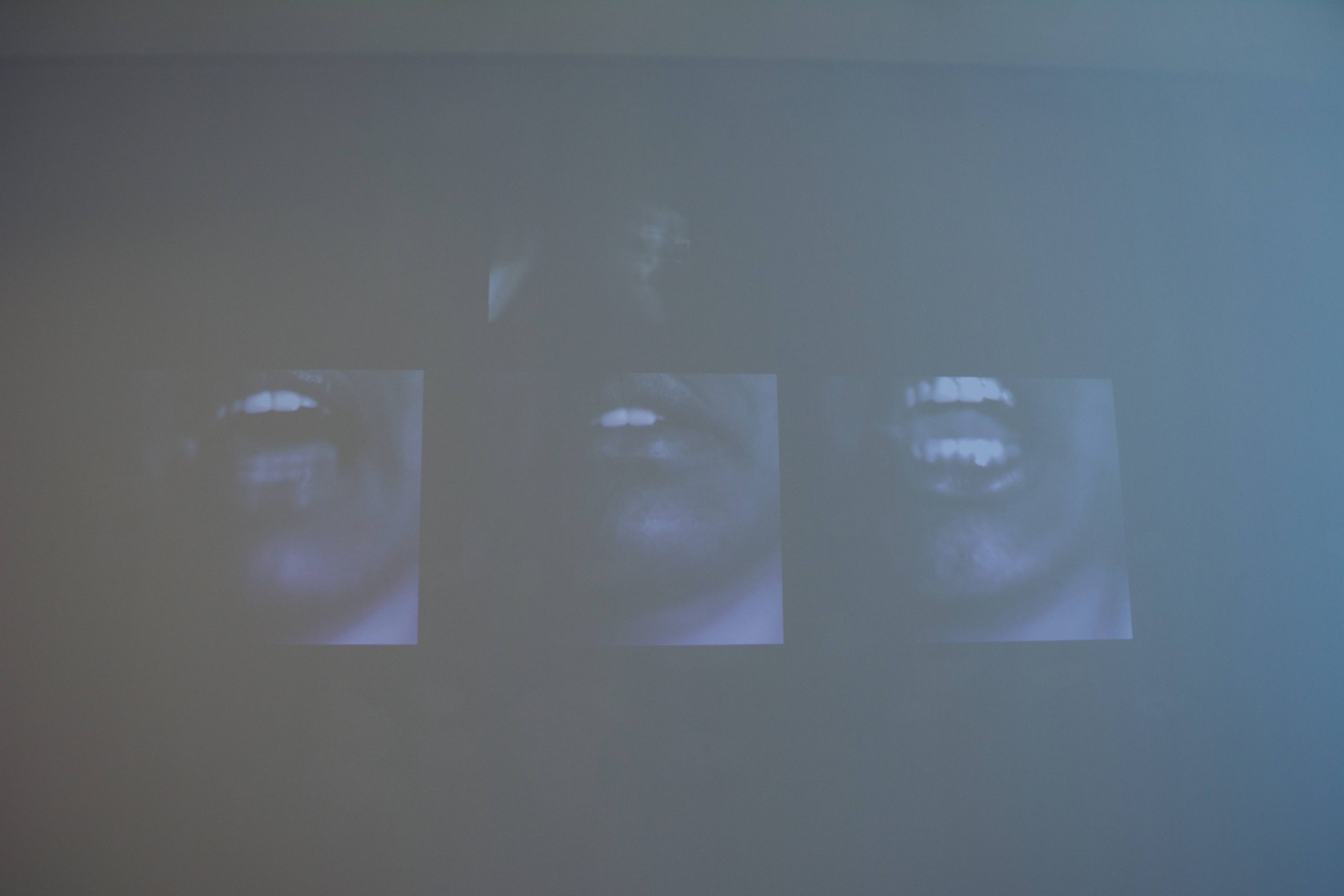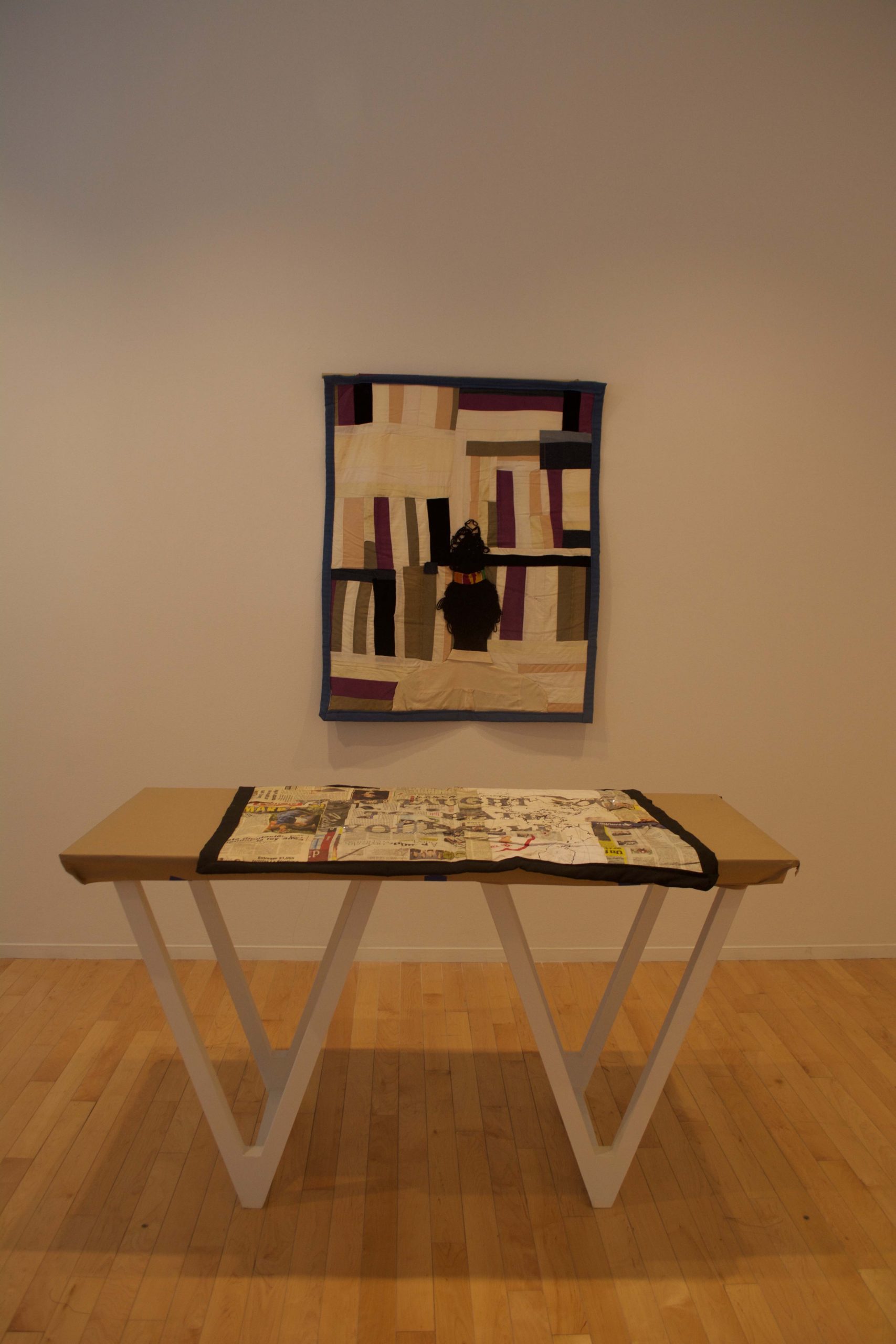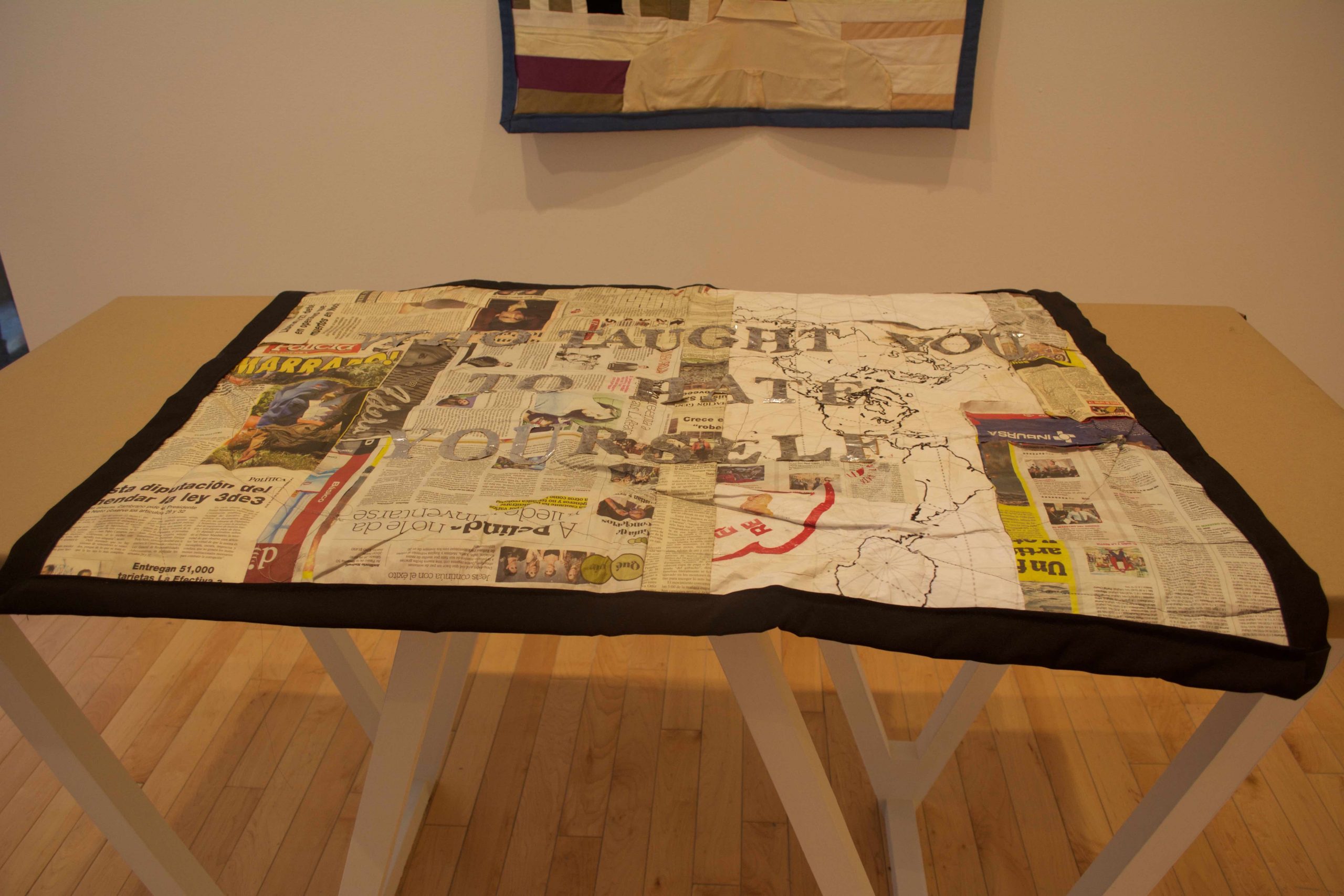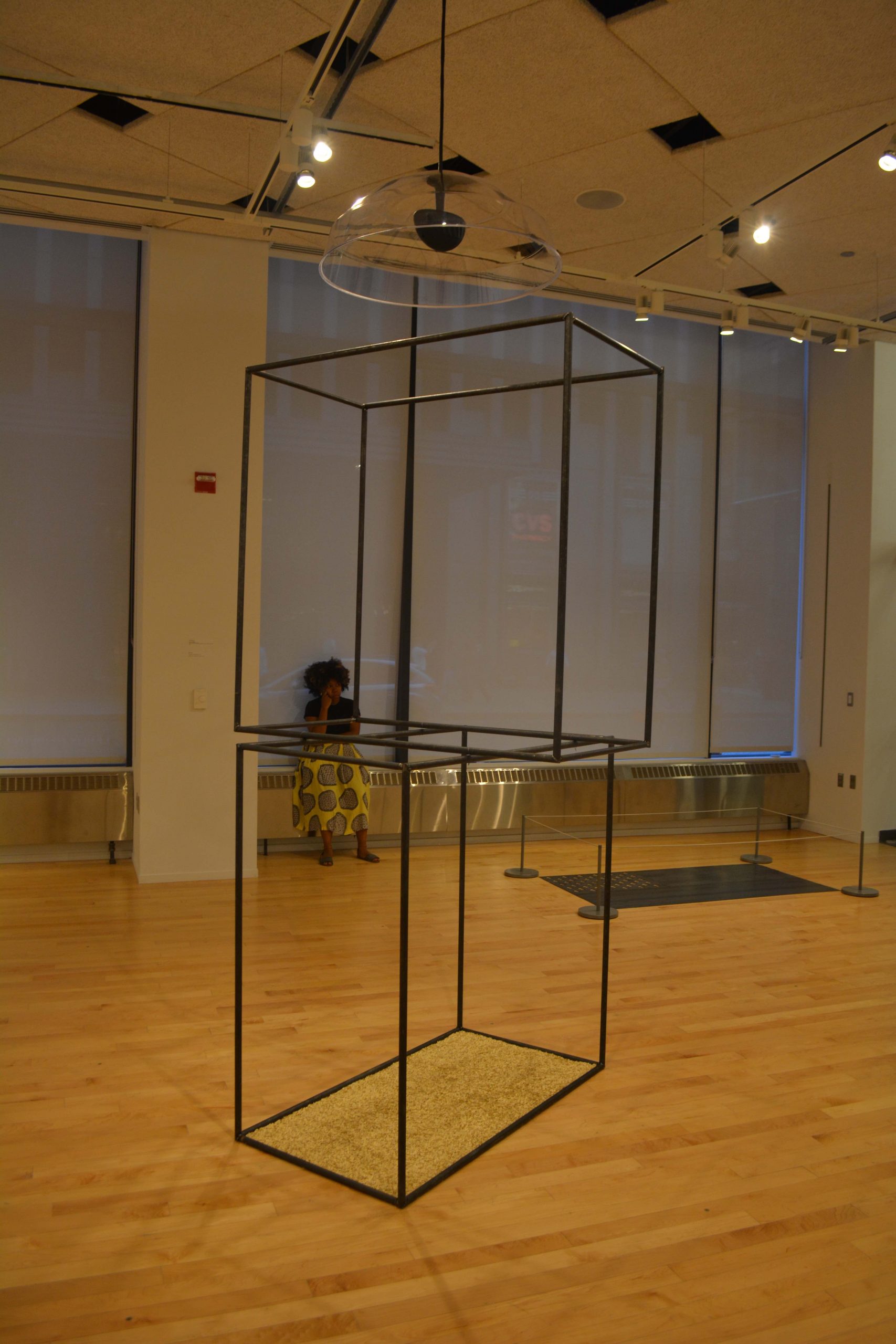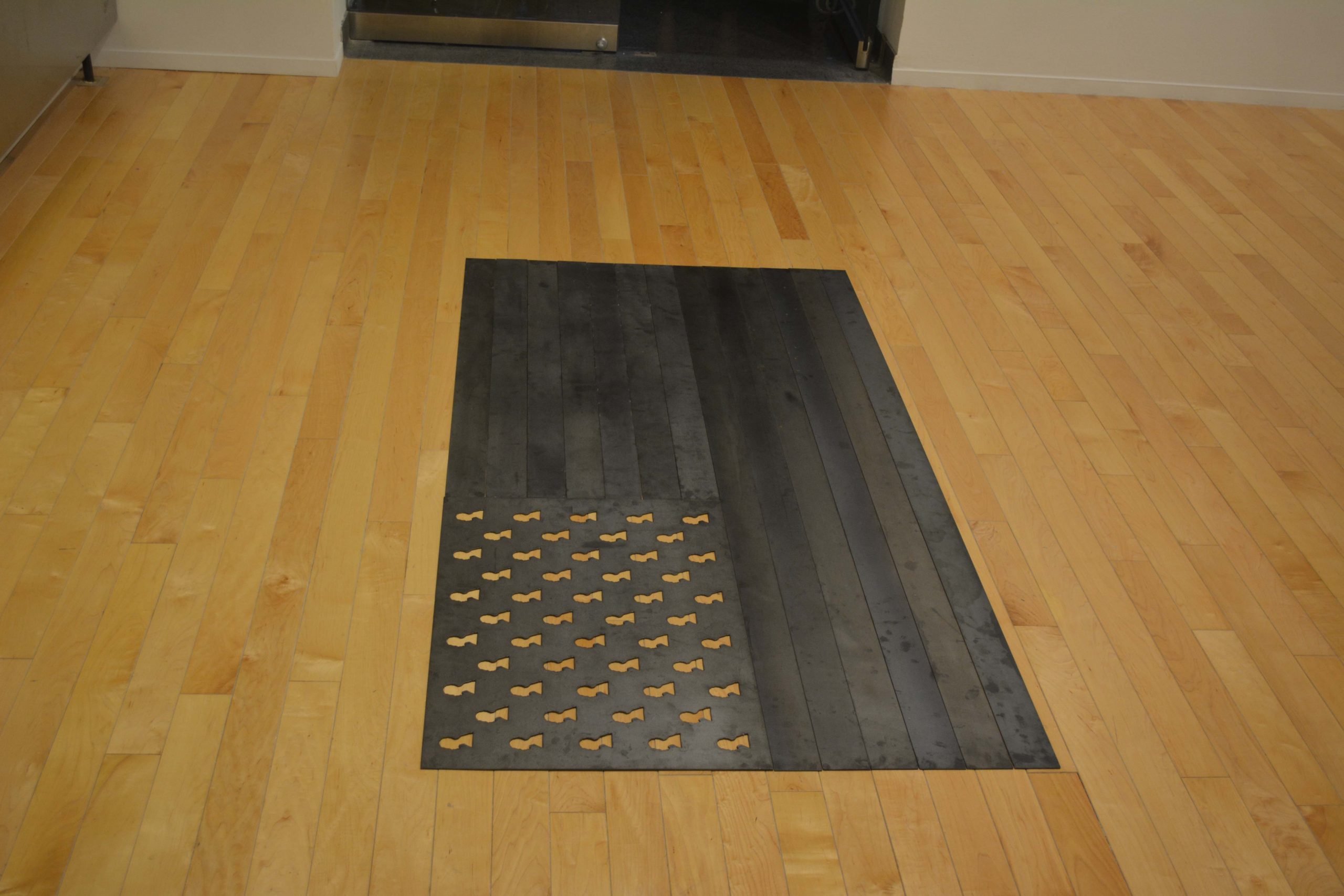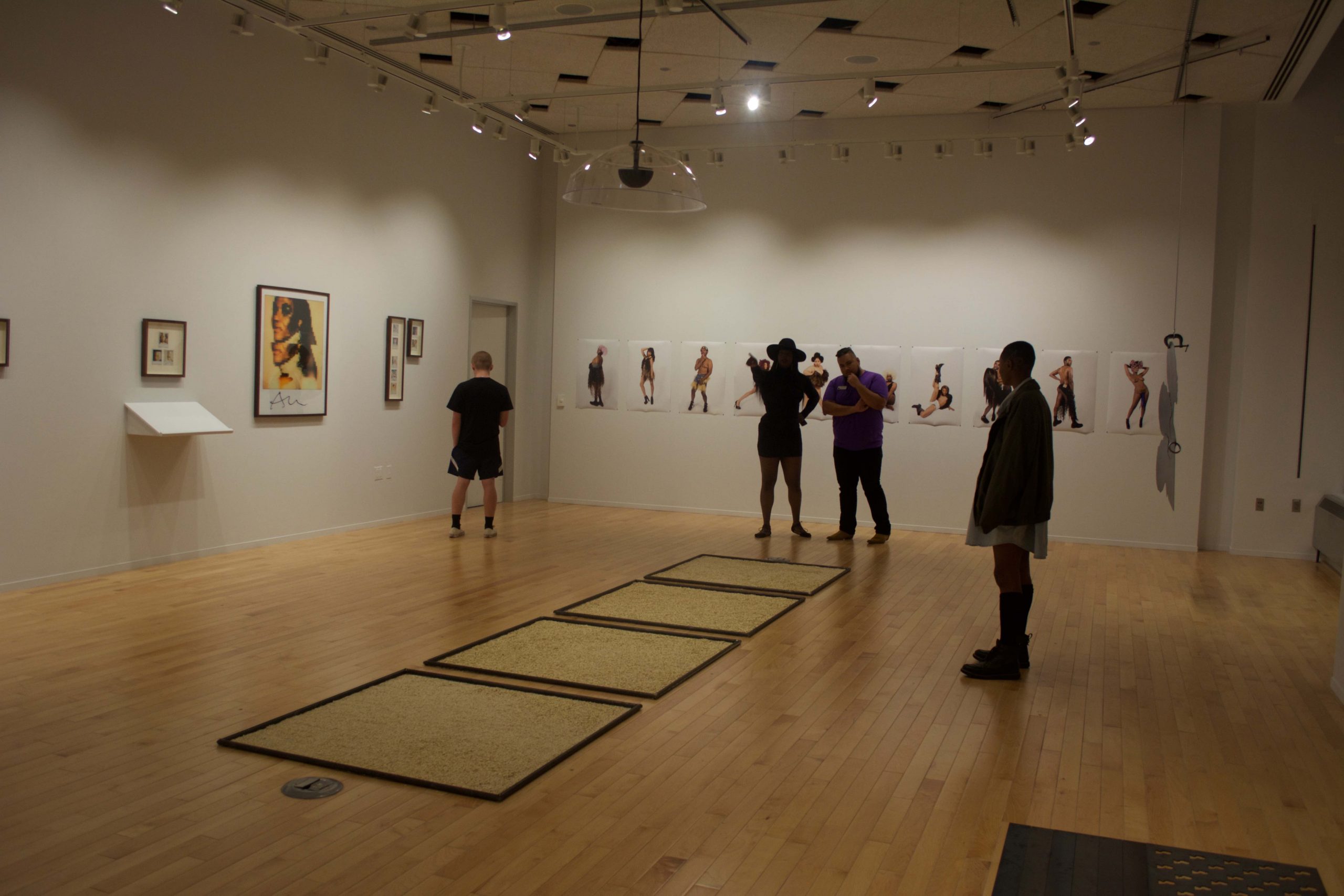De Nue
2016
September 2 – September 25
LNC Gallery & Gallery X
Curators
Da’Niro Elle Brown, Brianna McIntyre, Janelle Ayana Miller
Contributing Artists
Patrice Barnes, Da’Niro Elle Brown, Itunuoluwa Ebijimi, Darren Edwards, André Fuqua, Jesús Hilario-Reyes, Shala Miller, Tiana Marie Mincey, Amina Ross, Derrick Woods-Marrow
Programs
- Soft/VIP Opening Reception
- Public Opening Reception
- Satellite Libraries presents Open TV
- De Nue Exchange
September 1, 4:00 – 6:00 PM
Gallery X
Program Statement from the SUGs/SITE archive:
“De Nue organizers are holding an invite-only soft opening of their expansive exhibition that occupies both of the Student Union Galleries’ (SITE) spaces. Light refreshments will be served and a performance by Jesús Hilario-Reyes titled negro maricon, will be staged for the duration of the opening. This reception is an intimate event for friends and family of the exhibitions organizers to celebrate the start of De Nue’s program schedule and unveiling.
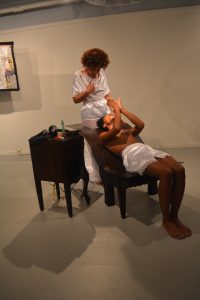
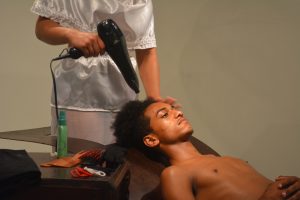

September 2, 6:00 – 9:00 PM
LeRoy Neiman Center
Program statement from the SUGs/SITE archive:
“De Nue is an exhibition featuring emerging BLACK artists from the SAIC community, curated by Da’Niro Elle Brown (BFA 2017), Janelle Miller (BFA 2017), and Brianna McIntyre (BFA 2017). Filling the LeRoy Neiman Center Gallery, Gallery X and the display cases of the Flaxman Library and the Joan Flasch Artists’ Book Collection, this exhibition was a confrontation, challenging SAIC and the public to complicate its ideas of Blackness and what it means to make BLACK art. The opening reception will include a performance titled Break-Down conceived by Da’Niro Elle Brown and a sound piece performed by Darren Edwards. Senegalese food from Yassa African Restaurant was served and was free to all guests.”
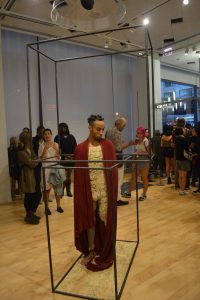
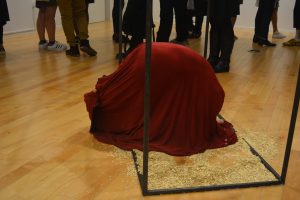
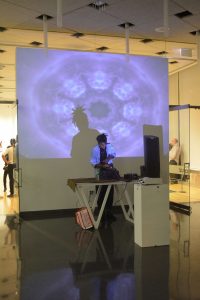
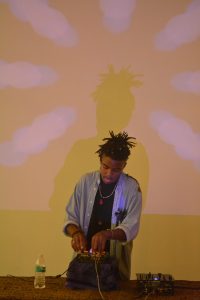
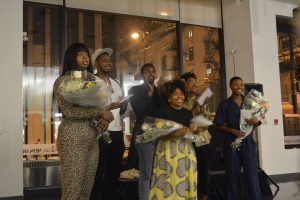
September 6, 4:00 – 6:00 PM
LNC Gallery
Program statement from the SUGs/SITE archive:
“Satellite Libraries are a curated selection of artist made books and print materials being presented in the Flaxman Library and Joan Flasch Artist Book Collection display cases. The artworks being presented are all made by artists of color that have attended SAIC. For a public event, Satellite Libraries partnered with Open TV. Open TV is an internet platform presenting web series created by artists who identify as queer, trans, cis-women, and persons of color. The produced series highlight diverse communities often left out of mainstream film and television through various production methods. Open TV screened a selection of their latest web series that follow the lives local Chicago artists.”
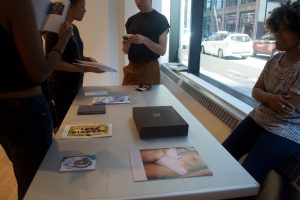
September 13, 4:00 – 6:00 PM
LeRoy Neiman Center Lobby
Program statment from the SUGs/SITE archive:
“De Nue Exchange is a workshop for students to acquaint themselves with the various support systems CHicago has to offer emerging artists including grants, residencies, and work spaces. Along with this portion of the program will be a panel discussion about life as an emerging artist, access to agency, and the strive for “diversity” in the context of institutional art. ‘With a Black population of three-percent and forty-two percent retention rate, it is important for SAIC to cultivate informed artistic and professional growth in students to continue the presence of diverse thought and culture in Chicago.'”
This event was coordinated by De Nue co-curator, Brianna McIntyre with support from Kate Schutta of Career and Professional Development (CAPX). The panelists included Alexandria Eregbu, Dana Bassett, Jordan Martins, Kenrick McFarlane in conversation with Brianna McIntyre. Round Tables: Acres, DCASE, Luminarts, Homan Square, Latitude Chicago, Hyde Park Arts Center, BOLT?CAC, 3Arts, Mission Projects, Rebuild Foundation.
Exhibition Material
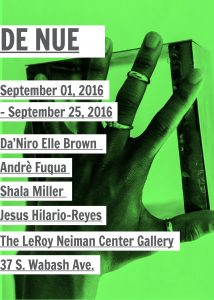
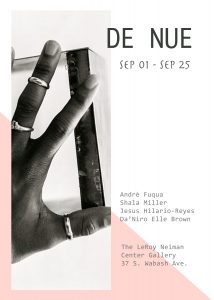
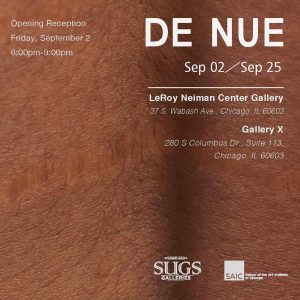
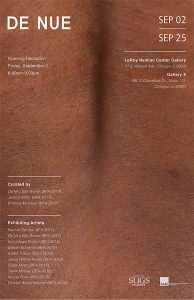
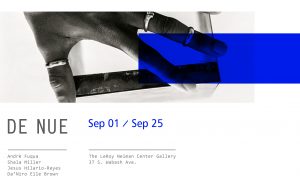
SAIC’s student-run fnews Magazine covered De Nue and the exhibition’s programming.
A Test Run for Test Site, SUG’s new Summer Residency
‘De Nue’ Kicks off the Student Union Galleries’ Fall Season
Black Contemporary Artists Control Their Visibility in SUGs’ ‘De Nue’
De Nue
Satallite Libraries are a curated selection of artist made boks and printed materials being presented in the Flaxman Library and Joan Flasch Artist Book Collection display cases. The artworks being presented are all made by artists of color that have attended SAIC. For a public event, Satellite Libraries is partnering with Open TV. Open TV is an internet platform presenting web series created by artists who identify as queer, trans, cis-women, and persons of color. The produced series highight diverse communities often left our of maintream film and television through various production methods. Open TV will be screening a selection of their latest web series that follow the lives of local Chicago artists.
De Team:
Da’Niro Elle Brown (head curator and art director), Janelle Ayana Miller (assistant curator and programmer), Brianna McIntyre (assistant curator and programmer), Roderick Sawyer (photographer), Bruno Suarez Bango (graphic designer)
De Jurors:
Faheem Majeed, Felicia Mings, Aymar Jean “AJ” Christian, Beatrix Erica Brooks
Essays by:
Claire Smith (The Wake: somone who cried hoping it would stir some pity in my chest), Ryan Blocker (Subject: Personal), Madison Smith (Ho-fessional Deconstructing Gender and Sex in Hip-Hop Videos of the Early 2000’s), Tiana Marie Mincey (Politics of Visibility: Afro-Mexicanos)
De Artists:
Patrice Barnes, Da’Niro Elle Brown, Itunuoluwa Ebijimi, Darren Edwards, Andre Fuqua, Jesus Hilario-Reyes, Shala Miller, Tiana Marie Mincey, Amina Ross, Derrick Woods-Morrow
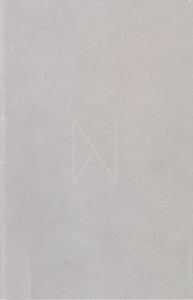
Patrice Barnes
My upbringing and connection to Chicago has played a major role in my practice and my goals as an artist. My practice consists of addressing and reflecting on my life experiences of growing up on the south side of Chicago and my understanding of the social issues many people face in that area and areas alike. The key points that come up in my work are: neighborhod violence, deprivation of resources and support, the mental effects from one’s environment, and survivior’s guilt. The most significant of those points, neighborhood violence, consists of the loss of my brother in2010. As I speak about him I do not wish to become his voice, instead, I want to share my experiences with him as he stands as an example of so many other young males in the city. I plan to advocate for my neighborhood and the people I know whose lives were taken because of the extreme amount of violence Chicago faces daily. Because of the unfamiliarity some people may have with the topics I address in my work, it can sometimes be an informative experience for my audience. I believe that telling my story and my brother’s story through my work can tear down stereotypical thinking about the people who are affected by the social issues that are key to my practice.
Paint is my most often used medium and my paitnings are primarily figurative. However, when I make sculptures, installations, or fiber pieces, the materials used will inform the subject matter. An example of this is the gravel installation under the paitning titled “Unseen”, in which the gravel material itself relates to the cemetary. When creating work, I start with an idea and allow myself to plan as I make. As I work, ideas form as to what I should do next to further my intentions. If I plan out my work too much, it feels disgenuine and causes me to be detached from the piece itself. This is especially important when dealing with life experiences because as I work on a project more aspects of my memories appear as I make.
Part of my advocacy is my desire to help create change within underprivleged and underdeveloped neighborhoods and schools so that the issues of neighborhood violence, lack of resources and support, and challenges with mental health are considerably decreased. Ultimately I would like to create my own not-for-profit in Chicago as an art therapist. It’s imperative to me to give back to the community in various ways so that the people and the conditions within the community can improve. It is the responsibility of artists who come from struggling communities to give back once they have prepared.
Da’Niro Elle Brown
Is a multidisciplinary visual artist whose practice is based on an exploration of the human form. Her work bridges across several medias incuding film, sculpture, performance, and photography. Diverse identities, theories and convictions come together in her work. Brown has a keen interest in process, evolution of sexuality, and intimacy to form. These interests are informed by society, speculation, and biological development.
Itunuoluwa Ebijimi
As queer Black woman. I am I constantly navigating spaces dominated by systematic white supremacy, sexism. and hetero/cisnormativitv. whether it be at school, public, or my home. As a result, I am left in a state of hyperawareness, always conscious of my presence and perception in relation to societv’s expectations or me. Inrough sculpture pertormance, and photography, I confront others assumptions and my questions of my own Blackness temininity, queerness, and personal history. Ultimately, my work confronts society’s systems of oppression, rejecting the simplification of my narrative and creating a space for others like me.
Darren Edwards
I’d like to believe that I’ve always been an artist or at least attracted to art in some shape or form. Whether It’d be music, or the visual side of the television shows I grew up watching, I’ve always been intrigued with it. Even in elementary school,would notice certain details about things that the other kids or even teachers would never pick up on. I’ve always been extremely curious and attentive to my surroundings, and the visual aspects everyday life. I’ve always chosen to do the opposite and be a leader/self-starter: contrary to what everyone else my age is doing/tocused on. Moving on to more recent times, I’d say art, or just the act of creating in general, Is my lite now. here Isn’t a second where don t think about creating something, or how I could improve an already existing piece I’ve finished. Whether it Is music, writing, or any creative outlet without set guideline/rules, I tend to naturally gravitate towards it. My process of art making differs with each creative endeavor I venture out on. I constantly come up with new ideas and was to challenge myselt creatively. I never stick to one medium, and I’m always up to try something new, or in a way I hadnt thought of previously. As a reflection of such, my art never stays in one medium, and continues to develop as I learn about and explore the world around me. I plan to create as much as physically possible. I want to exercise my gifts to their tullest capabilities in hopes of brightening the tuture of the world.
André Fuqua
Is an interdisciplinary artist working in drawing painting, photography, and sculpture. His extensive training in civil engineering and architecture quides much or his craft. His work is an exoloration or the ways that mediums can be composed using innovative practices and technologies to transcend boundaries or art, design, and engineering. Too, his work reveals the context of his own encounters. It is a reflection of his experiences seeing himselt being seen and histories regarding visibility, gaze, emergence, and power in relation to his identity. André believes that invisibility is a tension of beauty and pain: it exists as a duality or anxiety and desire. Using formal tropes and materiality, he explores ideas surrounding invisibility, otherness, identity, and body and their manifestation In social spheres from times past to present day.
Jesus Hilario-Reyes
My work is about the cultural significance/space that the black body occupies. It seeks to discuss the systematic and societal institutions that interact with my oppressed identities. Through protest and activism my performances narrate complex societal stigmas, that stem trom post-colonial trauma. like to view mv pertormances as a series of academic protests, that happen within and outside or the gallery space. My 2D/sculpture work seeks to discuss the representation of the patriotic essence of being Latinx. I’m particularly Interested in the ritualistic culture of being atro-latinx and how patriotism and colonial ideals converse with my identity through internalized actions and social interactions.
Shala Miller
I’m going to let this statement be in pieces. I was trying to make it really nice, clean and smooth because wanted to be a serious art woman and I thought, “A serious art woman would make it nice clean and smooth in about 150 words”. And I kind of did that. I don’t know it it’s smoothest or the nicest but its in a pretty clean 150, or something close to it:
Photography, video, sound, text and drawing are all elements of my artistic medium but tend to spend most of my time working with image making. Primarily working in a personal domain, I consider the root of my work to be an investigation of the self. My wonderment in regards to identity and the qualities of its construction, serve as the thematic intrastructure for my work. I believe that my practice creates the opportunity to project teelings or concerns that don’t posses an ease in their ability to be articulated. My goal is to take those emotions and turn them into material, giving it a voice. But only a voice that has the capacity to visually speak.
That’s 117 words. That’s also what I’ve been copying and pasting into any box titled, Artist Statement for the past two years. I don’t want to fully get rid of it because I believe the sentiment echoes into this new, not so nice, not so smooth statement in pieces.
I love that me and my mom both know about Little Sally Walker from the schoolyard. I love that when I was 7 Miss. Mary Mack was still dressed in black. “In My Diary” by Etta James is like gospel to me and l eavesdrop too much.
Right now, I’m interested in the different levels of language and conversation. Whether it’s the language or a photograph and its poetic capabilities or the conversation between the soprano and alto.
Tiana Mincey
My work expands across demarcations of identity. The idea of “who am I” has expanded into “who we are” as a country, as a western civilization, as consumerists and as imperialists. I am interested all of the ditterent groups one can belong to essentially wearing many ditterent identities. Working with found materials such as clothing, and text allows me to explore and dissect the various places I have come to call home.
How do the structures that make up my home continue to marginalize, oppress and disavow entire groups of people? How can I begin to dissect the racial, economic, and ecological injustices that flourish in our societies? Denim, human hair and natural dyes act as recurring motits in my textile and ceramic objects.
An interest in referencing the human body, or a mass of bodies through these materials connects the infatuation with all three. Many of my source materials are part of a process-based acquisition, most being tound, bartered, or hand-made, providing me with a connection to their existence. Pieced fabrics exolore the inter-connection between different ideas, experiences and cultures.
Use of traditional. historical methods of craft making such as quilting, mat making and crocheting allow me to bean a conversation about the past and the present, about home and identity.
Amina Ross
“The body, manifold” is a poetic phrase derived from mv own writings that I return to again and again. Manifold, meaning. the quality or state or being multiple and various. Through repetition, I relay the manitold and multivocal nature of visual and written language. I use whatever I may get my hands on to reevaluate the identity and meaning or the objects-subjects within my work, providing these object-subjects with a crucial agency.
This practice is poetics.
My poetics posits that “the capacity, condition, or state or acting or or exerting power” may be sought through abstraction. There is a peculiar breakdown that happens through repetition. In the constant coming back to an image, a motion an obiect, a form; meaning is lost, altered, amplified, misconstrued. There is potential here. This practice is performative collaborative and consciously constructed. bearing in mind the traditional roles and identities of the director, doctor salesperson. perormer- I play with these roles by creating safe yet challenging means of production. Each piece is dedicated to a transparency of process the use of quotidian materials and familiar images to create quasi-immersive wars that may be deconstructed and revealed upon prolonged viewing. As of late these interests have led to an exploration of conceptions of Body and Beauty within communities dedicated to aternative modes of healing. This work explores the mechanism of “the loop” (seamless repetition) within video, movement, form, music, and history.
There is something seductive about a cyclical motion.
Derrick Woods-Morrow
My work, photography, pertormance, social practice, sculpture and installation, tocuses on the problem of being an object of other people’s expectation, while the same time, struggling to locate a sense of self-hood beyond those expectations. I draw from personal history. and examine the “locations” or homoerotic activity and their relation to the mainstream ideals or masculinity circulating in American visual culture.
Engrained within the political landscape of Chicago, activism has often been centered on civil rights, not only along the lines of the marginalized and the color of their skin, but also LGBQT rights, and the rights to one’s own body, and sexual treedom. And yet, even within the margins there exists prejudices suggesting who and what should be considered desirable, leading to even further marginalization or those people deemed non-normative. I engage with patriarchal figures of Chicago, often times activating dialogue about gender identity, and race relations, suggesting to them, that their identities are not fixed and yet constructed through their navigation of preconceived ideals.
By doing so my intent is to gain insight into this exclusionary structure, understand belter how it functions and further destabilize these fixed notions through my multimedia approach to art making.
The photographs exolore how desire operates in relation to cultural assumptions and stereotypes based on race, class and masculinity – highlighting my navigation as a black queer male and the resulting prejudices faced within Chicago’s north side. My engagement in this work is an attempt to locate myself in relationship to the domestic space or other males — spaces to which I am invited but that are also fraught with identifications and ideologies that do not welcome me.
Performative gestures socially activate sites of contention, highlighted in the male subjects who perform tor the camera in my series, Whitewash, which displays acts of subversion such as public indecency, captured in the sexually activated cruising sites of Chicago’s gay male scene.

